Report on Inclusive Practice for DET Course Students
VerifiedAdded on 2022/12/26
|18
|6435
|11
Report
AI Summary
This report provides a comprehensive overview of inclusive practice within an educational context, likely a DET (Diploma in Education and Training) course. It begins by examining the impact of personal, social, cultural, cognitive, physical, and sensory factors on learning. The report then delves into policy and regulatory frameworks, including the Equality Act 2010 and anti-discrimination acts, and how these influence organizational policies related to inclusive practice. It explores the author's role and responsibilities in promoting inclusion, including identifying referral points to meet individual learning needs. The report further analyzes the key features and benefits of an inclusive learning environment, strategies for promoting inclusion, and effective liaison between professionals. Finally, it reviews the effectiveness of the author's own inclusive practice, identifying strengths and areas for improvement. The report aims to increase understanding and develop skills in inclusive practices within a learning environment.
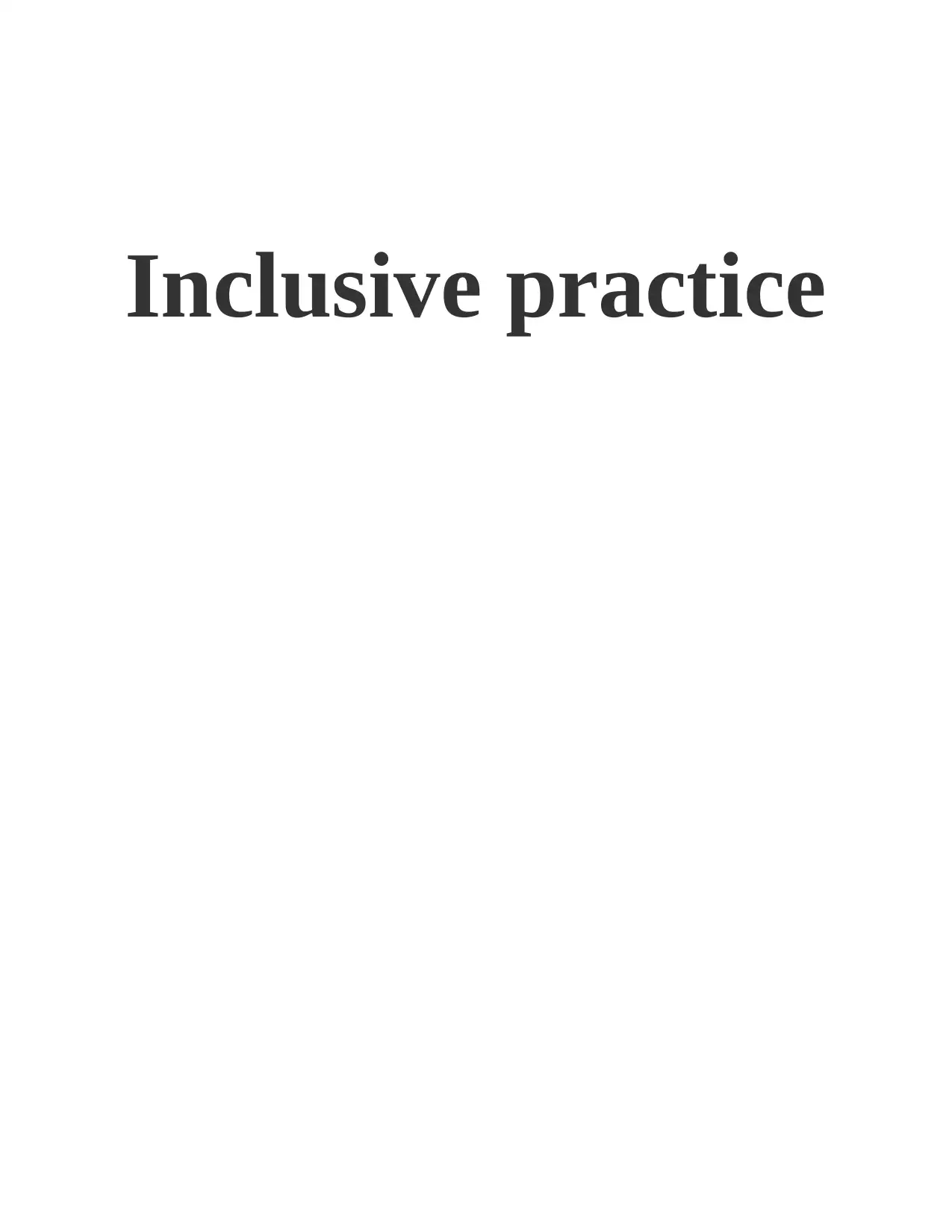
Inclusive practice
Paraphrase This Document
Need a fresh take? Get an instant paraphrase of this document with our AI Paraphraser

Table of Contents
INTRODUCTION...........................................................................................................................1
MAIN BODY...................................................................................................................................1
LO1..................................................................................................................................................1
1.1 Review the impact of personal, social and cultural factors on learning................................1
1.2 Review the impact of different cognitive, physical and sensory abilities on learning..........2
LO2..................................................................................................................................................2
2.1Summarise policy and regulatory frameworks relating to inclusive practice.........................2
2.2 Explain how policy and regulatory frameworks influence organisational policies relating to
inclusive practice.........................................................................................................................3
2.3 Explain how policy and regulatory frameworks influence organisational policies relating to
inclusive practice.........................................................................................................................3
LO3..................................................................................................................................................3
3.1 Summarise own role and responsibilities relating to inclusive practice................................3
Explain the relationship between own role and the roles of other professionals involved in
inclusive practice.........................................................................................................................4
Identify points of referral available to meet individual learning needs.......................................4
LO4..................................................................................................................................................5
Review key features and benefits of an inclusive learning environment.....................................5
Analyse ways to promote inclusion.............................................................................................8
Review strategies for effective liaison between professionals involved in inclusive practice....8
LO5..................................................................................................................................................9
Review the effectiveness of own inclusive practice....................................................................9
Identify own strengths and areas for improvement in relation to inclusive practice...................9
Identify own strengths and areas for improvement in relation to inclusive practice.................10
CONCLUSION..............................................................................................................................10
REFERENCE ................................................................................................................................11
INTRODUCTION...........................................................................................................................1
MAIN BODY...................................................................................................................................1
LO1..................................................................................................................................................1
1.1 Review the impact of personal, social and cultural factors on learning................................1
1.2 Review the impact of different cognitive, physical and sensory abilities on learning..........2
LO2..................................................................................................................................................2
2.1Summarise policy and regulatory frameworks relating to inclusive practice.........................2
2.2 Explain how policy and regulatory frameworks influence organisational policies relating to
inclusive practice.........................................................................................................................3
2.3 Explain how policy and regulatory frameworks influence organisational policies relating to
inclusive practice.........................................................................................................................3
LO3..................................................................................................................................................3
3.1 Summarise own role and responsibilities relating to inclusive practice................................3
Explain the relationship between own role and the roles of other professionals involved in
inclusive practice.........................................................................................................................4
Identify points of referral available to meet individual learning needs.......................................4
LO4..................................................................................................................................................5
Review key features and benefits of an inclusive learning environment.....................................5
Analyse ways to promote inclusion.............................................................................................8
Review strategies for effective liaison between professionals involved in inclusive practice....8
LO5..................................................................................................................................................9
Review the effectiveness of own inclusive practice....................................................................9
Identify own strengths and areas for improvement in relation to inclusive practice...................9
Identify own strengths and areas for improvement in relation to inclusive practice.................10
CONCLUSION..............................................................................................................................10
REFERENCE ................................................................................................................................11
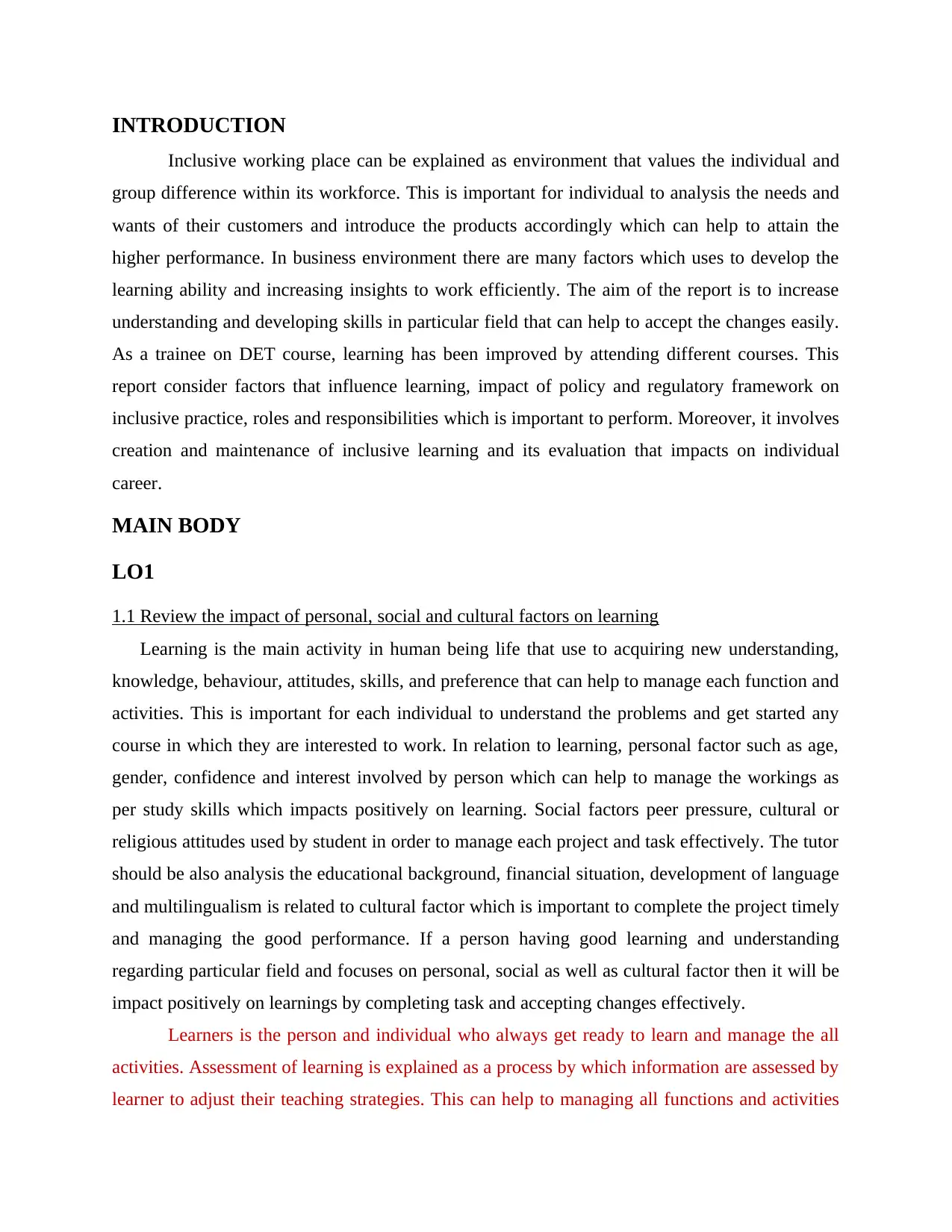
INTRODUCTION
Inclusive working place can be explained as environment that values the individual and
group difference within its workforce. This is important for individual to analysis the needs and
wants of their customers and introduce the products accordingly which can help to attain the
higher performance. In business environment there are many factors which uses to develop the
learning ability and increasing insights to work efficiently. The aim of the report is to increase
understanding and developing skills in particular field that can help to accept the changes easily.
As a trainee on DET course, learning has been improved by attending different courses. This
report consider factors that influence learning, impact of policy and regulatory framework on
inclusive practice, roles and responsibilities which is important to perform. Moreover, it involves
creation and maintenance of inclusive learning and its evaluation that impacts on individual
career.
MAIN BODY
LO1
1.1 Review the impact of personal, social and cultural factors on learning
Learning is the main activity in human being life that use to acquiring new understanding,
knowledge, behaviour, attitudes, skills, and preference that can help to manage each function and
activities. This is important for each individual to understand the problems and get started any
course in which they are interested to work. In relation to learning, personal factor such as age,
gender, confidence and interest involved by person which can help to manage the workings as
per study skills which impacts positively on learning. Social factors peer pressure, cultural or
religious attitudes used by student in order to manage each project and task effectively. The tutor
should be also analysis the educational background, financial situation, development of language
and multilingualism is related to cultural factor which is important to complete the project timely
and managing the good performance. If a person having good learning and understanding
regarding particular field and focuses on personal, social as well as cultural factor then it will be
impact positively on learnings by completing task and accepting changes effectively.
Learners is the person and individual who always get ready to learn and manage the all
activities. Assessment of learning is explained as a process by which information are assessed by
learner to adjust their teaching strategies. This can help to managing all functions and activities
Inclusive working place can be explained as environment that values the individual and
group difference within its workforce. This is important for individual to analysis the needs and
wants of their customers and introduce the products accordingly which can help to attain the
higher performance. In business environment there are many factors which uses to develop the
learning ability and increasing insights to work efficiently. The aim of the report is to increase
understanding and developing skills in particular field that can help to accept the changes easily.
As a trainee on DET course, learning has been improved by attending different courses. This
report consider factors that influence learning, impact of policy and regulatory framework on
inclusive practice, roles and responsibilities which is important to perform. Moreover, it involves
creation and maintenance of inclusive learning and its evaluation that impacts on individual
career.
MAIN BODY
LO1
1.1 Review the impact of personal, social and cultural factors on learning
Learning is the main activity in human being life that use to acquiring new understanding,
knowledge, behaviour, attitudes, skills, and preference that can help to manage each function and
activities. This is important for each individual to understand the problems and get started any
course in which they are interested to work. In relation to learning, personal factor such as age,
gender, confidence and interest involved by person which can help to manage the workings as
per study skills which impacts positively on learning. Social factors peer pressure, cultural or
religious attitudes used by student in order to manage each project and task effectively. The tutor
should be also analysis the educational background, financial situation, development of language
and multilingualism is related to cultural factor which is important to complete the project timely
and managing the good performance. If a person having good learning and understanding
regarding particular field and focuses on personal, social as well as cultural factor then it will be
impact positively on learnings by completing task and accepting changes effectively.
Learners is the person and individual who always get ready to learn and manage the all
activities. Assessment of learning is explained as a process by which information are assessed by
learner to adjust their teaching strategies. This can help to managing all functions and activities
⊘ This is a preview!⊘
Do you want full access?
Subscribe today to unlock all pages.

Trusted by 1+ million students worldwide
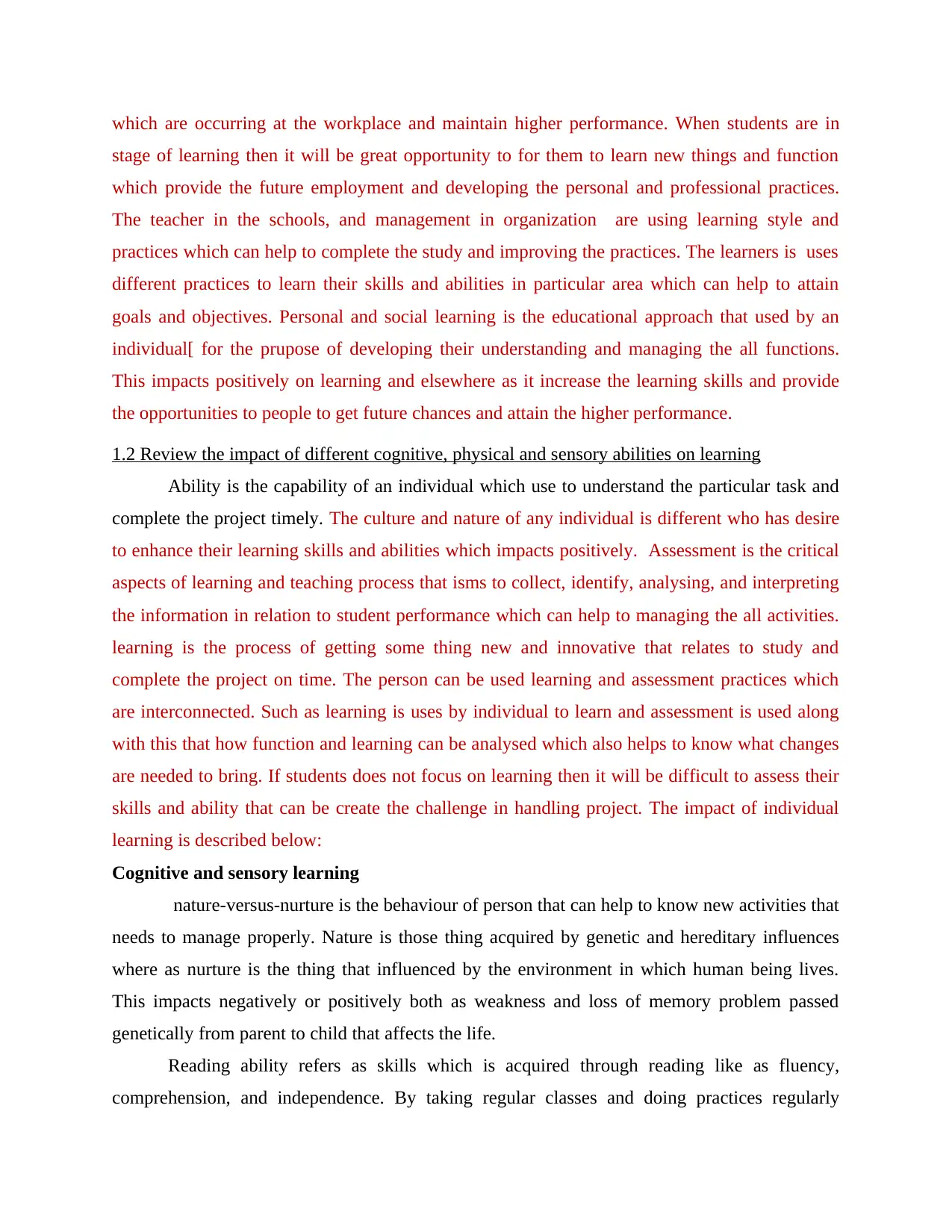
which are occurring at the workplace and maintain higher performance. When students are in
stage of learning then it will be great opportunity to for them to learn new things and function
which provide the future employment and developing the personal and professional practices.
The teacher in the schools, and management in organization are using learning style and
practices which can help to complete the study and improving the practices. The learners is uses
different practices to learn their skills and abilities in particular area which can help to attain
goals and objectives. Personal and social learning is the educational approach that used by an
individual[ for the prupose of developing their understanding and managing the all functions.
This impacts positively on learning and elsewhere as it increase the learning skills and provide
the opportunities to people to get future chances and attain the higher performance.
1.2 Review the impact of different cognitive, physical and sensory abilities on learning
Ability is the capability of an individual which use to understand the particular task and
complete the project timely. The culture and nature of any individual is different who has desire
to enhance their learning skills and abilities which impacts positively. Assessment is the critical
aspects of learning and teaching process that isms to collect, identify, analysing, and interpreting
the information in relation to student performance which can help to managing the all activities.
learning is the process of getting some thing new and innovative that relates to study and
complete the project on time. The person can be used learning and assessment practices which
are interconnected. Such as learning is uses by individual to learn and assessment is used along
with this that how function and learning can be analysed which also helps to know what changes
are needed to bring. If students does not focus on learning then it will be difficult to assess their
skills and ability that can be create the challenge in handling project. The impact of individual
learning is described below:
Cognitive and sensory learning
nature-versus-nurture is the behaviour of person that can help to know new activities that
needs to manage properly. Nature is those thing acquired by genetic and hereditary influences
where as nurture is the thing that influenced by the environment in which human being lives.
This impacts negatively or positively both as weakness and loss of memory problem passed
genetically from parent to child that affects the life.
Reading ability refers as skills which is acquired through reading like as fluency,
comprehension, and independence. By taking regular classes and doing practices regularly
stage of learning then it will be great opportunity to for them to learn new things and function
which provide the future employment and developing the personal and professional practices.
The teacher in the schools, and management in organization are using learning style and
practices which can help to complete the study and improving the practices. The learners is uses
different practices to learn their skills and abilities in particular area which can help to attain
goals and objectives. Personal and social learning is the educational approach that used by an
individual[ for the prupose of developing their understanding and managing the all functions.
This impacts positively on learning and elsewhere as it increase the learning skills and provide
the opportunities to people to get future chances and attain the higher performance.
1.2 Review the impact of different cognitive, physical and sensory abilities on learning
Ability is the capability of an individual which use to understand the particular task and
complete the project timely. The culture and nature of any individual is different who has desire
to enhance their learning skills and abilities which impacts positively. Assessment is the critical
aspects of learning and teaching process that isms to collect, identify, analysing, and interpreting
the information in relation to student performance which can help to managing the all activities.
learning is the process of getting some thing new and innovative that relates to study and
complete the project on time. The person can be used learning and assessment practices which
are interconnected. Such as learning is uses by individual to learn and assessment is used along
with this that how function and learning can be analysed which also helps to know what changes
are needed to bring. If students does not focus on learning then it will be difficult to assess their
skills and ability that can be create the challenge in handling project. The impact of individual
learning is described below:
Cognitive and sensory learning
nature-versus-nurture is the behaviour of person that can help to know new activities that
needs to manage properly. Nature is those thing acquired by genetic and hereditary influences
where as nurture is the thing that influenced by the environment in which human being lives.
This impacts negatively or positively both as weakness and loss of memory problem passed
genetically from parent to child that affects the life.
Reading ability refers as skills which is acquired through reading like as fluency,
comprehension, and independence. By taking regular classes and doing practices regularly
Paraphrase This Document
Need a fresh take? Get an instant paraphrase of this document with our AI Paraphraser

individual can give clear meaning to the turn words. This is important for individual to become a
fluent in reading that can help to develop opportunities.
Analytical skills is explained as ability to deconstruct information in to smaller category
for drawing conclusions, This consist of logical reasoning, critical thinking, research,
communication, and creativity that can be used to complete any task and managing performance.
Physical ability on learning
Aptitude is the component of competence that can help to work in certain level. This can
be in the form of mental and physical form that develop the abilities to handle particular task.
This impacts positively by developing skills and attaining the personal goals.
Skill development is affecting the learning positively as it build the confidence level of
students who ready to work and take participation in different courses.
Physical disability is another aspect which impacts negatively on learning as it affects the
skills and working capabilities of individuals. Physical talents have an important influence in
early childhood learning. The physical capacities that a child can draw on while engaging with
the world are strongly tied to the form of learning that the youngster engages in. More
complicated learning occurs as physical abilities improve.
Sensory ability on learning
Sensory skills can be defined as vision, touch, hearing, smell, vestibular, and taste that
should have in person for understanding the learning skills and managing the all functions. The
people should have ability to enough learning and feeling something different which can help to
make feel good and attaining the higher performance. Sensory processing disorders are not even
a learning problem or an official diagnosis, but they can make it difficult for kids to succeed in
school. According to a 2009 study, one out of every six children has sensory difficulties that
make it difficult for them to learn and perform in school.
LO2
2.1Summarise policy and regulatory frameworks relating to inclusive practice
Licences, network regulations, connection agreements, market rules standards, and
performance contracts are all part of the regulatory framework. Permitting, licensing, and
regulatory approvals Formulation, design, execution, management, taxes, and subsidies are all
examples of funds and policy instruments. This is important for individual to understand and
fluent in reading that can help to develop opportunities.
Analytical skills is explained as ability to deconstruct information in to smaller category
for drawing conclusions, This consist of logical reasoning, critical thinking, research,
communication, and creativity that can be used to complete any task and managing performance.
Physical ability on learning
Aptitude is the component of competence that can help to work in certain level. This can
be in the form of mental and physical form that develop the abilities to handle particular task.
This impacts positively by developing skills and attaining the personal goals.
Skill development is affecting the learning positively as it build the confidence level of
students who ready to work and take participation in different courses.
Physical disability is another aspect which impacts negatively on learning as it affects the
skills and working capabilities of individuals. Physical talents have an important influence in
early childhood learning. The physical capacities that a child can draw on while engaging with
the world are strongly tied to the form of learning that the youngster engages in. More
complicated learning occurs as physical abilities improve.
Sensory ability on learning
Sensory skills can be defined as vision, touch, hearing, smell, vestibular, and taste that
should have in person for understanding the learning skills and managing the all functions. The
people should have ability to enough learning and feeling something different which can help to
make feel good and attaining the higher performance. Sensory processing disorders are not even
a learning problem or an official diagnosis, but they can make it difficult for kids to succeed in
school. According to a 2009 study, one out of every six children has sensory difficulties that
make it difficult for them to learn and perform in school.
LO2
2.1Summarise policy and regulatory frameworks relating to inclusive practice
Licences, network regulations, connection agreements, market rules standards, and
performance contracts are all part of the regulatory framework. Permitting, licensing, and
regulatory approvals Formulation, design, execution, management, taxes, and subsidies are all
examples of funds and policy instruments. This is important for individual to understand and

follow the rules and regulation which can help to develop to organizational productivity and
personal skills.
Equality Act 2010: This regulation should be adopted by all companies and learning
class in which equal opportunity should be provided to individual and getting the work done
effectively. This can help to manage the all functions and activities as people works
collaboratively and using their skills.
Anti-discrimination act – This is an act which is formulated to provide the safe data and
information to the people. As per this, no personal data of any employees and individual should
be leak that can help to operate the business and increase the organizational performance. This
make sure their customers their and employees that their data will be safe and secure that willj
help to maintain higher performance.
Increasing flexibility programme: This is another policy and regulation that should be
adopted by tutor while providing study classes. This can help to develop the understanding of
individual and manage the each task.
Policy and regulations are the important framework that should be follow by an
individual for the purpose of running all functions and activities effectively.
2.2 Explain how policy and regulatory frameworks influence organisational policies relating to
inclusive practice
Policy and regulatory framework in relation to learning is important as it develop the
understanding level of individual and provide them right suggestion that can help to build
confidence to work properly. Such as Criminal record Bureau procedures should be follow that
supports to know future abilities. Giving more time to dyslexic students, and nominating roles
and responsibilities are important regulations that are important to follow and managing the
higher performance. Inclusive education aims to meet and respond to the diverse needs of
students by increasing their participation in school, cultural values, and community activities, as
well as reducing marginalization inside the classroom. The framework include information on
stakeholders' duties, such as children and educators, on policies that provide direction and
expectations for developing and maintaining a secure and favourable atmosphere in which
everyone feels at ease to stay and engage with one another. This encourages everyone to adopt
positive behaviors and give their all in order to fulfil their duties and responsibilities, which must
be acknowledged for and reflected in employee evaluations and performance appraisals. Staff
personal skills.
Equality Act 2010: This regulation should be adopted by all companies and learning
class in which equal opportunity should be provided to individual and getting the work done
effectively. This can help to manage the all functions and activities as people works
collaboratively and using their skills.
Anti-discrimination act – This is an act which is formulated to provide the safe data and
information to the people. As per this, no personal data of any employees and individual should
be leak that can help to operate the business and increase the organizational performance. This
make sure their customers their and employees that their data will be safe and secure that willj
help to maintain higher performance.
Increasing flexibility programme: This is another policy and regulation that should be
adopted by tutor while providing study classes. This can help to develop the understanding of
individual and manage the each task.
Policy and regulations are the important framework that should be follow by an
individual for the purpose of running all functions and activities effectively.
2.2 Explain how policy and regulatory frameworks influence organisational policies relating to
inclusive practice
Policy and regulatory framework in relation to learning is important as it develop the
understanding level of individual and provide them right suggestion that can help to build
confidence to work properly. Such as Criminal record Bureau procedures should be follow that
supports to know future abilities. Giving more time to dyslexic students, and nominating roles
and responsibilities are important regulations that are important to follow and managing the
higher performance. Inclusive education aims to meet and respond to the diverse needs of
students by increasing their participation in school, cultural values, and community activities, as
well as reducing marginalization inside the classroom. The framework include information on
stakeholders' duties, such as children and educators, on policies that provide direction and
expectations for developing and maintaining a secure and favourable atmosphere in which
everyone feels at ease to stay and engage with one another. This encourages everyone to adopt
positive behaviors and give their all in order to fulfil their duties and responsibilities, which must
be acknowledged for and reflected in employee evaluations and performance appraisals. Staff
⊘ This is a preview!⊘
Do you want full access?
Subscribe today to unlock all pages.

Trusted by 1+ million students worldwide
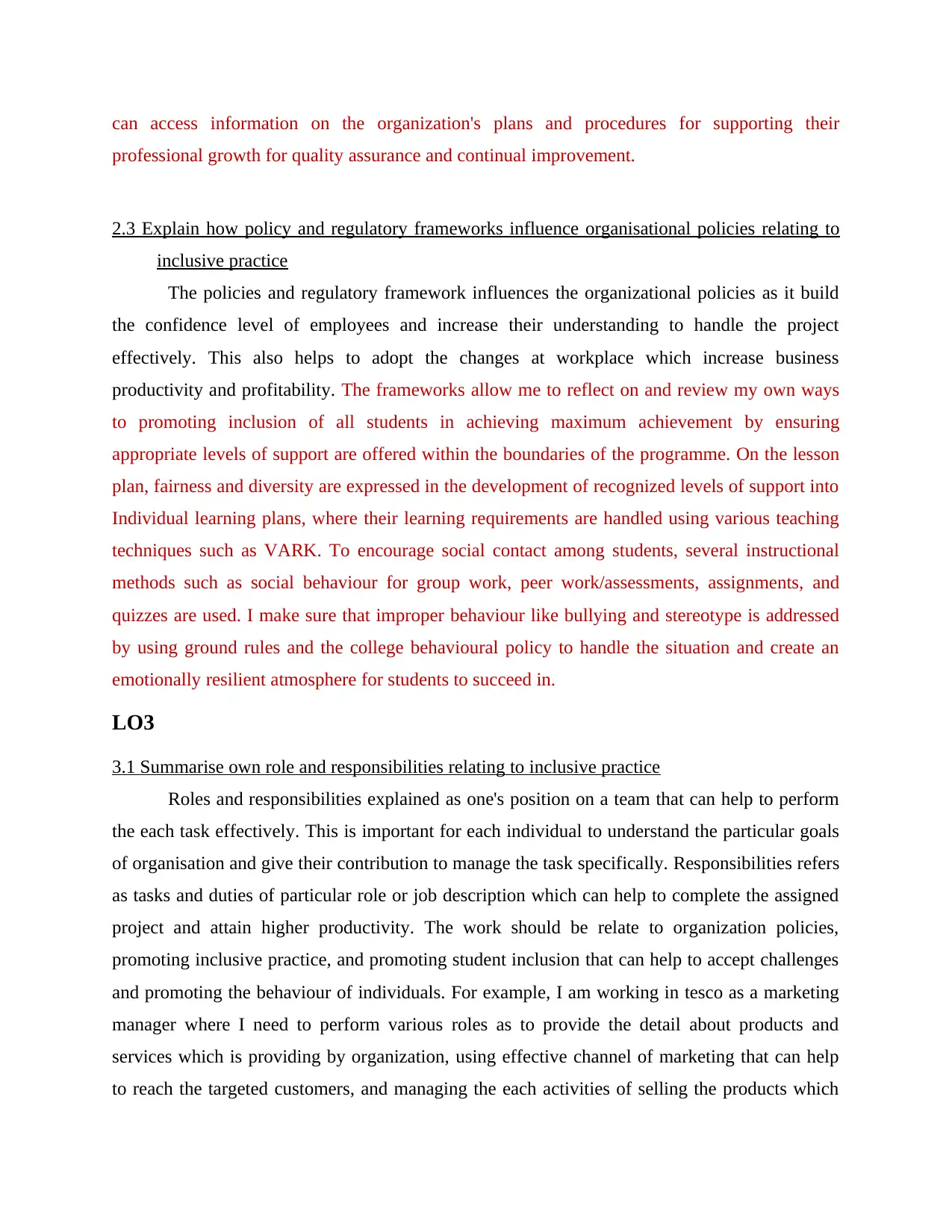
can access information on the organization's plans and procedures for supporting their
professional growth for quality assurance and continual improvement.
2.3 Explain how policy and regulatory frameworks influence organisational policies relating to
inclusive practice
The policies and regulatory framework influences the organizational policies as it build
the confidence level of employees and increase their understanding to handle the project
effectively. This also helps to adopt the changes at workplace which increase business
productivity and profitability. The frameworks allow me to reflect on and review my own ways
to promoting inclusion of all students in achieving maximum achievement by ensuring
appropriate levels of support are offered within the boundaries of the programme. On the lesson
plan, fairness and diversity are expressed in the development of recognized levels of support into
Individual learning plans, where their learning requirements are handled using various teaching
techniques such as VARK. To encourage social contact among students, several instructional
methods such as social behaviour for group work, peer work/assessments, assignments, and
quizzes are used. I make sure that improper behaviour like bullying and stereotype is addressed
by using ground rules and the college behavioural policy to handle the situation and create an
emotionally resilient atmosphere for students to succeed in.
LO3
3.1 Summarise own role and responsibilities relating to inclusive practice
Roles and responsibilities explained as one's position on a team that can help to perform
the each task effectively. This is important for each individual to understand the particular goals
of organisation and give their contribution to manage the task specifically. Responsibilities refers
as tasks and duties of particular role or job description which can help to complete the assigned
project and attain higher productivity. The work should be relate to organization policies,
promoting inclusive practice, and promoting student inclusion that can help to accept challenges
and promoting the behaviour of individuals. For example, I am working in tesco as a marketing
manager where I need to perform various roles as to provide the detail about products and
services which is providing by organization, using effective channel of marketing that can help
to reach the targeted customers, and managing the each activities of selling the products which
professional growth for quality assurance and continual improvement.
2.3 Explain how policy and regulatory frameworks influence organisational policies relating to
inclusive practice
The policies and regulatory framework influences the organizational policies as it build
the confidence level of employees and increase their understanding to handle the project
effectively. This also helps to adopt the changes at workplace which increase business
productivity and profitability. The frameworks allow me to reflect on and review my own ways
to promoting inclusion of all students in achieving maximum achievement by ensuring
appropriate levels of support are offered within the boundaries of the programme. On the lesson
plan, fairness and diversity are expressed in the development of recognized levels of support into
Individual learning plans, where their learning requirements are handled using various teaching
techniques such as VARK. To encourage social contact among students, several instructional
methods such as social behaviour for group work, peer work/assessments, assignments, and
quizzes are used. I make sure that improper behaviour like bullying and stereotype is addressed
by using ground rules and the college behavioural policy to handle the situation and create an
emotionally resilient atmosphere for students to succeed in.
LO3
3.1 Summarise own role and responsibilities relating to inclusive practice
Roles and responsibilities explained as one's position on a team that can help to perform
the each task effectively. This is important for each individual to understand the particular goals
of organisation and give their contribution to manage the task specifically. Responsibilities refers
as tasks and duties of particular role or job description which can help to complete the assigned
project and attain higher productivity. The work should be relate to organization policies,
promoting inclusive practice, and promoting student inclusion that can help to accept challenges
and promoting the behaviour of individuals. For example, I am working in tesco as a marketing
manager where I need to perform various roles as to provide the detail about products and
services which is providing by organization, using effective channel of marketing that can help
to reach the targeted customers, and managing the each activities of selling the products which
Paraphrase This Document
Need a fresh take? Get an instant paraphrase of this document with our AI Paraphraser
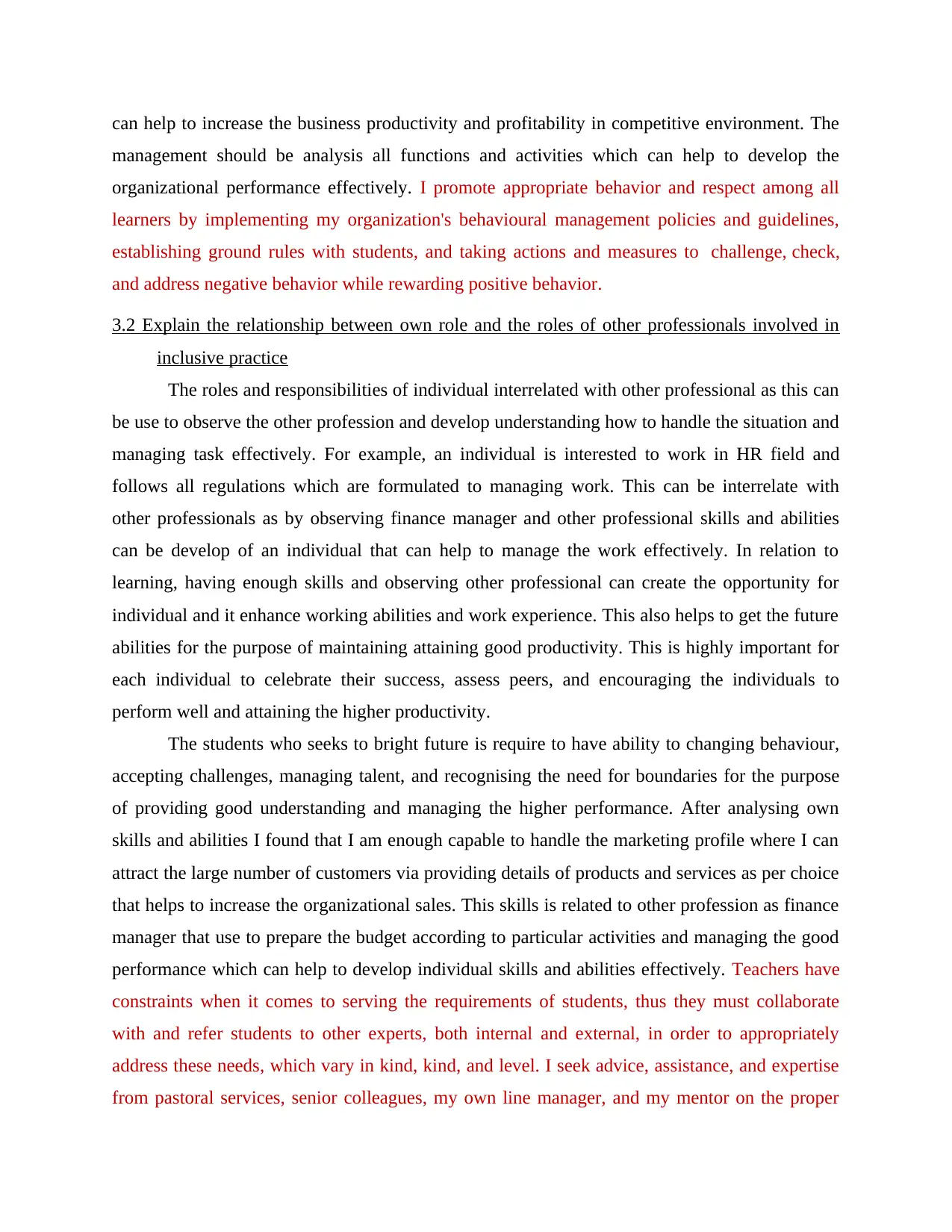
can help to increase the business productivity and profitability in competitive environment. The
management should be analysis all functions and activities which can help to develop the
organizational performance effectively. I promote appropriate behavior and respect among all
learners by implementing my organization's behavioural management policies and guidelines,
establishing ground rules with students, and taking actions and measures to challenge, check,
and address negative behavior while rewarding positive behavior.
3.2 Explain the relationship between own role and the roles of other professionals involved in
inclusive practice
The roles and responsibilities of individual interrelated with other professional as this can
be use to observe the other profession and develop understanding how to handle the situation and
managing task effectively. For example, an individual is interested to work in HR field and
follows all regulations which are formulated to managing work. This can be interrelate with
other professionals as by observing finance manager and other professional skills and abilities
can be develop of an individual that can help to manage the work effectively. In relation to
learning, having enough skills and observing other professional can create the opportunity for
individual and it enhance working abilities and work experience. This also helps to get the future
abilities for the purpose of maintaining attaining good productivity. This is highly important for
each individual to celebrate their success, assess peers, and encouraging the individuals to
perform well and attaining the higher productivity.
The students who seeks to bright future is require to have ability to changing behaviour,
accepting challenges, managing talent, and recognising the need for boundaries for the purpose
of providing good understanding and managing the higher performance. After analysing own
skills and abilities I found that I am enough capable to handle the marketing profile where I can
attract the large number of customers via providing details of products and services as per choice
that helps to increase the organizational sales. This skills is related to other profession as finance
manager that use to prepare the budget according to particular activities and managing the good
performance which can help to develop individual skills and abilities effectively. Teachers have
constraints when it comes to serving the requirements of students, thus they must collaborate
with and refer students to other experts, both internal and external, in order to appropriately
address these needs, which vary in kind, kind, and level. I seek advice, assistance, and expertise
from pastoral services, senior colleagues, my own line manager, and my mentor on the proper
management should be analysis all functions and activities which can help to develop the
organizational performance effectively. I promote appropriate behavior and respect among all
learners by implementing my organization's behavioural management policies and guidelines,
establishing ground rules with students, and taking actions and measures to challenge, check,
and address negative behavior while rewarding positive behavior.
3.2 Explain the relationship between own role and the roles of other professionals involved in
inclusive practice
The roles and responsibilities of individual interrelated with other professional as this can
be use to observe the other profession and develop understanding how to handle the situation and
managing task effectively. For example, an individual is interested to work in HR field and
follows all regulations which are formulated to managing work. This can be interrelate with
other professionals as by observing finance manager and other professional skills and abilities
can be develop of an individual that can help to manage the work effectively. In relation to
learning, having enough skills and observing other professional can create the opportunity for
individual and it enhance working abilities and work experience. This also helps to get the future
abilities for the purpose of maintaining attaining good productivity. This is highly important for
each individual to celebrate their success, assess peers, and encouraging the individuals to
perform well and attaining the higher productivity.
The students who seeks to bright future is require to have ability to changing behaviour,
accepting challenges, managing talent, and recognising the need for boundaries for the purpose
of providing good understanding and managing the higher performance. After analysing own
skills and abilities I found that I am enough capable to handle the marketing profile where I can
attract the large number of customers via providing details of products and services as per choice
that helps to increase the organizational sales. This skills is related to other profession as finance
manager that use to prepare the budget according to particular activities and managing the good
performance which can help to develop individual skills and abilities effectively. Teachers have
constraints when it comes to serving the requirements of students, thus they must collaborate
with and refer students to other experts, both internal and external, in order to appropriately
address these needs, which vary in kind, kind, and level. I seek advice, assistance, and expertise
from pastoral services, senior colleagues, my own line manager, and my mentor on the proper
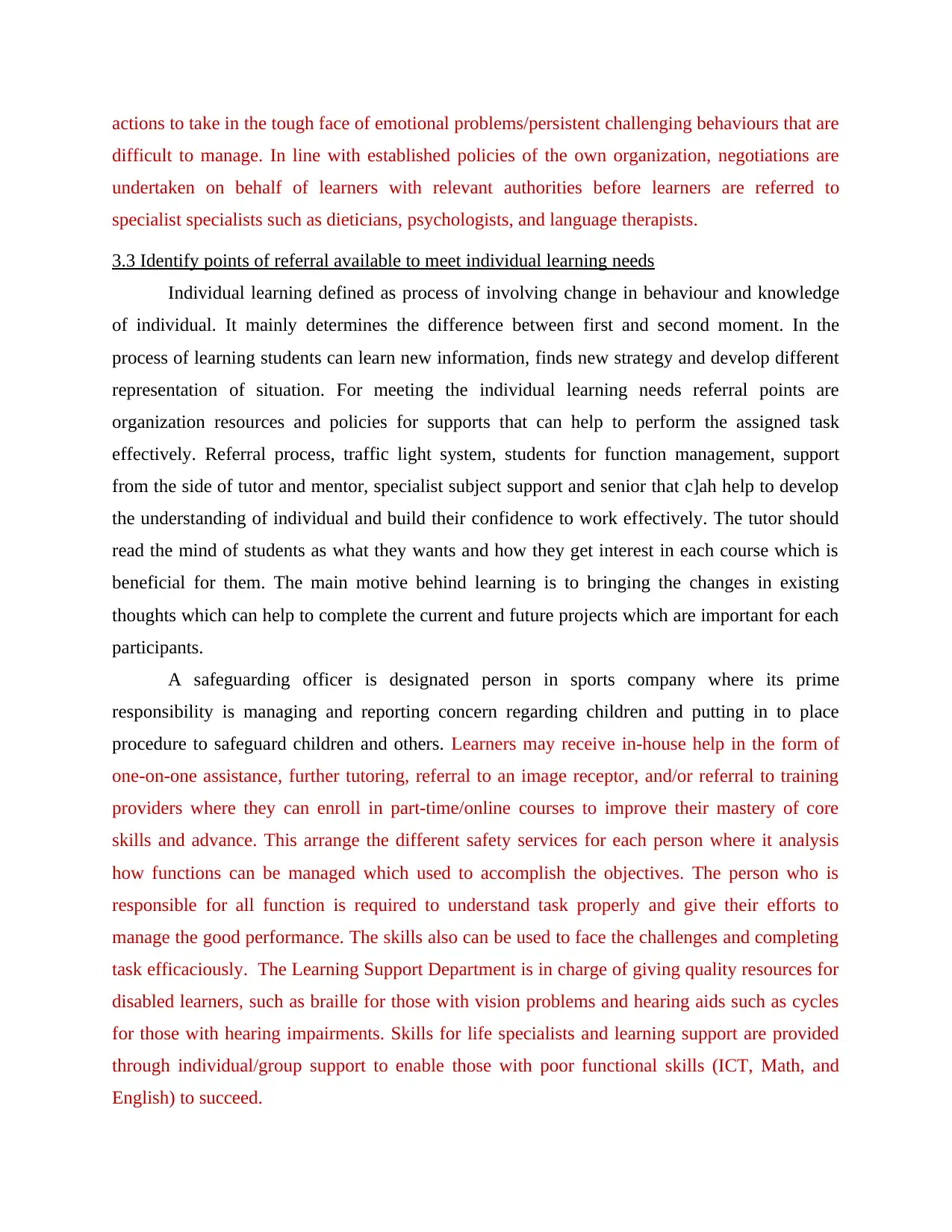
actions to take in the tough face of emotional problems/persistent challenging behaviours that are
difficult to manage. In line with established policies of the own organization, negotiations are
undertaken on behalf of learners with relevant authorities before learners are referred to
specialist specialists such as dieticians, psychologists, and language therapists.
3.3 Identify points of referral available to meet individual learning needs
Individual learning defined as process of involving change in behaviour and knowledge
of individual. It mainly determines the difference between first and second moment. In the
process of learning students can learn new information, finds new strategy and develop different
representation of situation. For meeting the individual learning needs referral points are
organization resources and policies for supports that can help to perform the assigned task
effectively. Referral process, traffic light system, students for function management, support
from the side of tutor and mentor, specialist subject support and senior that c]ah help to develop
the understanding of individual and build their confidence to work effectively. The tutor should
read the mind of students as what they wants and how they get interest in each course which is
beneficial for them. The main motive behind learning is to bringing the changes in existing
thoughts which can help to complete the current and future projects which are important for each
participants.
A safeguarding officer is designated person in sports company where its prime
responsibility is managing and reporting concern regarding children and putting in to place
procedure to safeguard children and others. Learners may receive in-house help in the form of
one-on-one assistance, further tutoring, referral to an image receptor, and/or referral to training
providers where they can enroll in part-time/online courses to improve their mastery of core
skills and advance. This arrange the different safety services for each person where it analysis
how functions can be managed which used to accomplish the objectives. The person who is
responsible for all function is required to understand task properly and give their efforts to
manage the good performance. The skills also can be used to face the challenges and completing
task efficaciously. The Learning Support Department is in charge of giving quality resources for
disabled learners, such as braille for those with vision problems and hearing aids such as cycles
for those with hearing impairments. Skills for life specialists and learning support are provided
through individual/group support to enable those with poor functional skills (ICT, Math, and
English) to succeed.
difficult to manage. In line with established policies of the own organization, negotiations are
undertaken on behalf of learners with relevant authorities before learners are referred to
specialist specialists such as dieticians, psychologists, and language therapists.
3.3 Identify points of referral available to meet individual learning needs
Individual learning defined as process of involving change in behaviour and knowledge
of individual. It mainly determines the difference between first and second moment. In the
process of learning students can learn new information, finds new strategy and develop different
representation of situation. For meeting the individual learning needs referral points are
organization resources and policies for supports that can help to perform the assigned task
effectively. Referral process, traffic light system, students for function management, support
from the side of tutor and mentor, specialist subject support and senior that c]ah help to develop
the understanding of individual and build their confidence to work effectively. The tutor should
read the mind of students as what they wants and how they get interest in each course which is
beneficial for them. The main motive behind learning is to bringing the changes in existing
thoughts which can help to complete the current and future projects which are important for each
participants.
A safeguarding officer is designated person in sports company where its prime
responsibility is managing and reporting concern regarding children and putting in to place
procedure to safeguard children and others. Learners may receive in-house help in the form of
one-on-one assistance, further tutoring, referral to an image receptor, and/or referral to training
providers where they can enroll in part-time/online courses to improve their mastery of core
skills and advance. This arrange the different safety services for each person where it analysis
how functions can be managed which used to accomplish the objectives. The person who is
responsible for all function is required to understand task properly and give their efforts to
manage the good performance. The skills also can be used to face the challenges and completing
task efficaciously. The Learning Support Department is in charge of giving quality resources for
disabled learners, such as braille for those with vision problems and hearing aids such as cycles
for those with hearing impairments. Skills for life specialists and learning support are provided
through individual/group support to enable those with poor functional skills (ICT, Math, and
English) to succeed.
⊘ This is a preview!⊘
Do you want full access?
Subscribe today to unlock all pages.

Trusted by 1+ million students worldwide

LO4
4.1 Review key features and benefits of an inclusive learning environment
The meaning of inclusive learning or teaching is enhancing skills, and respecting the
diversity of students. This enables all students to take part in learning classes and fulfil their
potential by managing learnings. This is important for each individual to bring the use of own
skills and abilities to complete the project and meeting learning needs. The another feature of
inclusive learning is ensuring different students that all preference are met regardless of learning
styles, abilities, background. The culture and needs of students is different where it registered
with different courses that can help to develop the understanding level and managing each work
effectively. The inclusive learning also use to develop the understanding in many field which can
help to handle the project and attaining higher performance. Instead than dividing pupils related
to physical disabilities, inclusion is an educational method that allows educators to learn
alongside other students. Even since inclusion emphasizes disabled students, teachers have a
responsibility to ensure that all students in both categories benefit from the implementation of a
demanding and relevant curriculum.
Benefits of Inclusive learning
By using the inclusive learning class size can be manage easily as limited number of
students are allowed in a classroom where teacher take different subject classes to
increase the understanding regarding particular topic.
An inclusive educational environment allows for the effective utilization of a variety of
teaching modalities to fulfill the stated needs of the learners.
To ensure that all learners are helped to attain their full potential, the teaching and
learning procedures include the use of relevant materials, learning styles (VARK),
diversified lesson plans, instructional methods, and techniques.
There is no greater concentration of student with disabilities in any classroom as special
classes be arranged by teacher for those students who are disable to learn in same way.
Manageable, shared transition can be shared between students and introduce changes in
relation to developing skills and abilities.
This provides an environment in which students can feel like they belong, have equal
possibilities, and have regard and value. Learner/teacher-centered approaches, active
4.1 Review key features and benefits of an inclusive learning environment
The meaning of inclusive learning or teaching is enhancing skills, and respecting the
diversity of students. This enables all students to take part in learning classes and fulfil their
potential by managing learnings. This is important for each individual to bring the use of own
skills and abilities to complete the project and meeting learning needs. The another feature of
inclusive learning is ensuring different students that all preference are met regardless of learning
styles, abilities, background. The culture and needs of students is different where it registered
with different courses that can help to develop the understanding level and managing each work
effectively. The inclusive learning also use to develop the understanding in many field which can
help to handle the project and attaining higher performance. Instead than dividing pupils related
to physical disabilities, inclusion is an educational method that allows educators to learn
alongside other students. Even since inclusion emphasizes disabled students, teachers have a
responsibility to ensure that all students in both categories benefit from the implementation of a
demanding and relevant curriculum.
Benefits of Inclusive learning
By using the inclusive learning class size can be manage easily as limited number of
students are allowed in a classroom where teacher take different subject classes to
increase the understanding regarding particular topic.
An inclusive educational environment allows for the effective utilization of a variety of
teaching modalities to fulfill the stated needs of the learners.
To ensure that all learners are helped to attain their full potential, the teaching and
learning procedures include the use of relevant materials, learning styles (VARK),
diversified lesson plans, instructional methods, and techniques.
There is no greater concentration of student with disabilities in any classroom as special
classes be arranged by teacher for those students who are disable to learn in same way.
Manageable, shared transition can be shared between students and introduce changes in
relation to developing skills and abilities.
This provides an environment in which students can feel like they belong, have equal
possibilities, and have regard and value. Learner/teacher-centered approaches, active
Paraphrase This Document
Need a fresh take? Get an instant paraphrase of this document with our AI Paraphraser
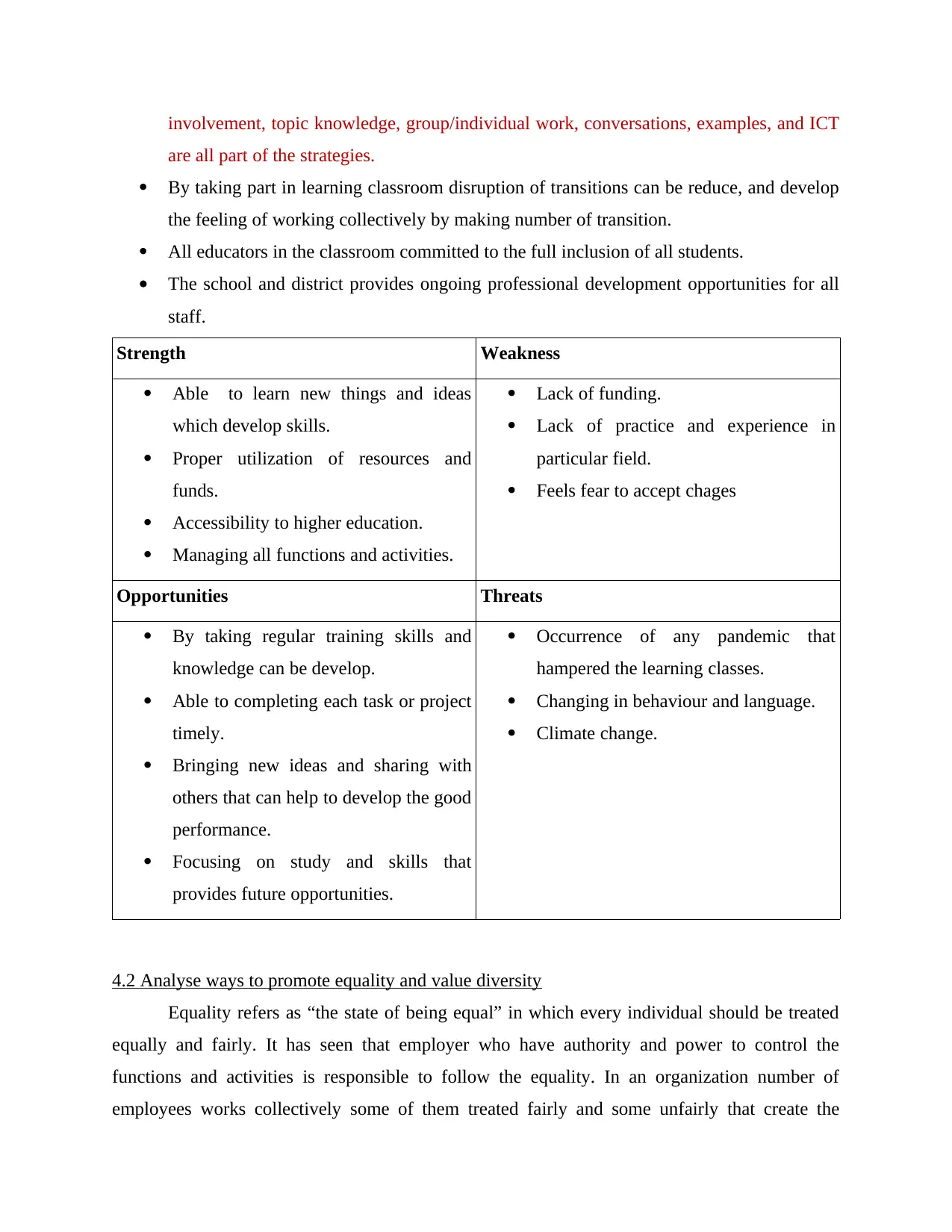
involvement, topic knowledge, group/individual work, conversations, examples, and ICT
are all part of the strategies.
By taking part in learning classroom disruption of transitions can be reduce, and develop
the feeling of working collectively by making number of transition.
All educators in the classroom committed to the full inclusion of all students.
The school and district provides ongoing professional development opportunities for all
staff.
Strength Weakness
Able to learn new things and ideas
which develop skills.
Proper utilization of resources and
funds.
Accessibility to higher education.
Managing all functions and activities.
Lack of funding.
Lack of practice and experience in
particular field.
Feels fear to accept chages
Opportunities Threats
By taking regular training skills and
knowledge can be develop.
Able to completing each task or project
timely.
Bringing new ideas and sharing with
others that can help to develop the good
performance.
Focusing on study and skills that
provides future opportunities.
Occurrence of any pandemic that
hampered the learning classes.
Changing in behaviour and language.
Climate change.
4.2 Analyse ways to promote equality and value diversity
Equality refers as “the state of being equal” in which every individual should be treated
equally and fairly. It has seen that employer who have authority and power to control the
functions and activities is responsible to follow the equality. In an organization number of
employees works collectively some of them treated fairly and some unfairly that create the
are all part of the strategies.
By taking part in learning classroom disruption of transitions can be reduce, and develop
the feeling of working collectively by making number of transition.
All educators in the classroom committed to the full inclusion of all students.
The school and district provides ongoing professional development opportunities for all
staff.
Strength Weakness
Able to learn new things and ideas
which develop skills.
Proper utilization of resources and
funds.
Accessibility to higher education.
Managing all functions and activities.
Lack of funding.
Lack of practice and experience in
particular field.
Feels fear to accept chages
Opportunities Threats
By taking regular training skills and
knowledge can be develop.
Able to completing each task or project
timely.
Bringing new ideas and sharing with
others that can help to develop the good
performance.
Focusing on study and skills that
provides future opportunities.
Occurrence of any pandemic that
hampered the learning classes.
Changing in behaviour and language.
Climate change.
4.2 Analyse ways to promote equality and value diversity
Equality refers as “the state of being equal” in which every individual should be treated
equally and fairly. It has seen that employer who have authority and power to control the
functions and activities is responsible to follow the equality. In an organization number of
employees works collectively some of them treated fairly and some unfairly that create the
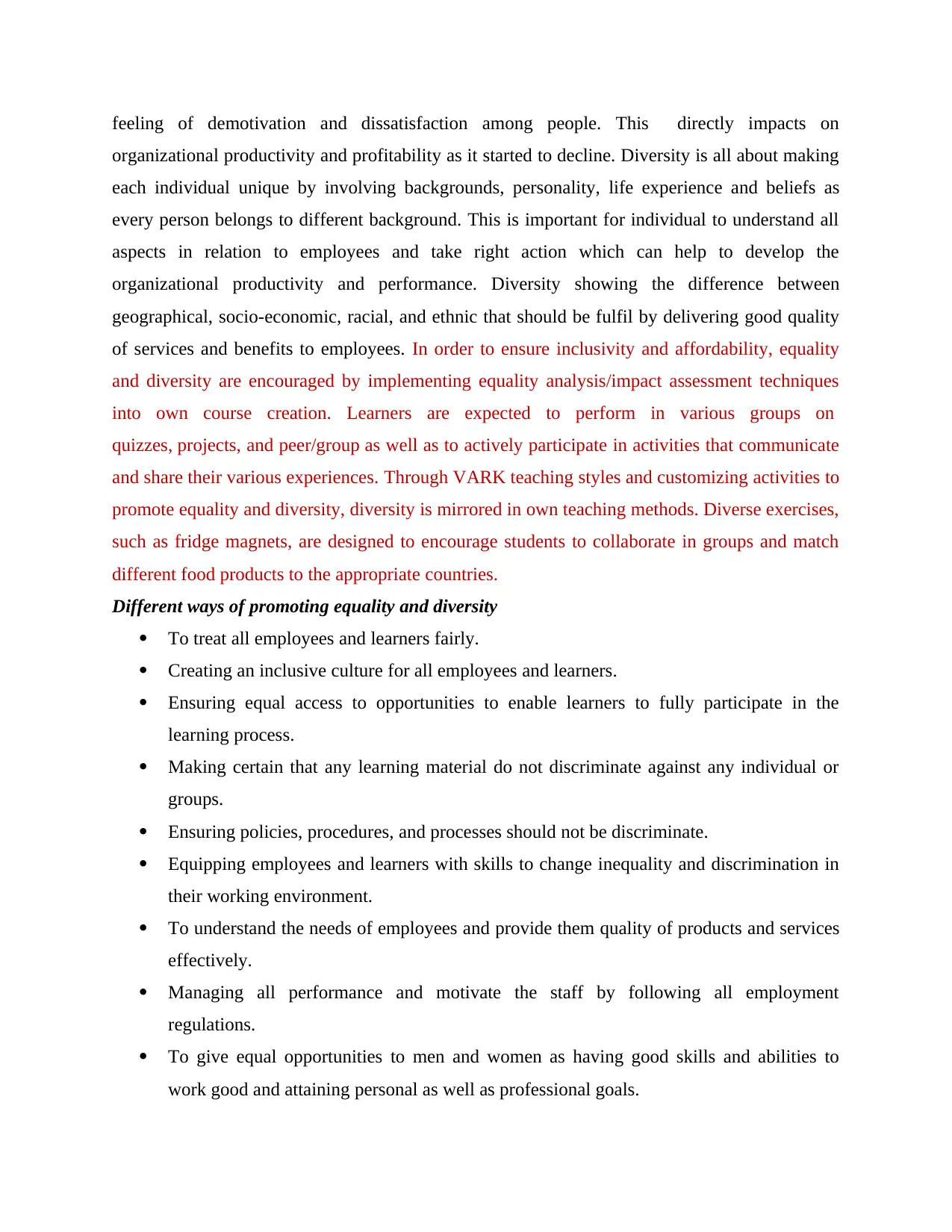
feeling of demotivation and dissatisfaction among people. This directly impacts on
organizational productivity and profitability as it started to decline. Diversity is all about making
each individual unique by involving backgrounds, personality, life experience and beliefs as
every person belongs to different background. This is important for individual to understand all
aspects in relation to employees and take right action which can help to develop the
organizational productivity and performance. Diversity showing the difference between
geographical, socio-economic, racial, and ethnic that should be fulfil by delivering good quality
of services and benefits to employees. In order to ensure inclusivity and affordability, equality
and diversity are encouraged by implementing equality analysis/impact assessment techniques
into own course creation. Learners are expected to perform in various groups on
quizzes, projects, and peer/group as well as to actively participate in activities that communicate
and share their various experiences. Through VARK teaching styles and customizing activities to
promote equality and diversity, diversity is mirrored in own teaching methods. Diverse exercises,
such as fridge magnets, are designed to encourage students to collaborate in groups and match
different food products to the appropriate countries.
Different ways of promoting equality and diversity
To treat all employees and learners fairly.
Creating an inclusive culture for all employees and learners.
Ensuring equal access to opportunities to enable learners to fully participate in the
learning process.
Making certain that any learning material do not discriminate against any individual or
groups.
Ensuring policies, procedures, and processes should not be discriminate.
Equipping employees and learners with skills to change inequality and discrimination in
their working environment.
To understand the needs of employees and provide them quality of products and services
effectively.
Managing all performance and motivate the staff by following all employment
regulations.
To give equal opportunities to men and women as having good skills and abilities to
work good and attaining personal as well as professional goals.
organizational productivity and profitability as it started to decline. Diversity is all about making
each individual unique by involving backgrounds, personality, life experience and beliefs as
every person belongs to different background. This is important for individual to understand all
aspects in relation to employees and take right action which can help to develop the
organizational productivity and performance. Diversity showing the difference between
geographical, socio-economic, racial, and ethnic that should be fulfil by delivering good quality
of services and benefits to employees. In order to ensure inclusivity and affordability, equality
and diversity are encouraged by implementing equality analysis/impact assessment techniques
into own course creation. Learners are expected to perform in various groups on
quizzes, projects, and peer/group as well as to actively participate in activities that communicate
and share their various experiences. Through VARK teaching styles and customizing activities to
promote equality and diversity, diversity is mirrored in own teaching methods. Diverse exercises,
such as fridge magnets, are designed to encourage students to collaborate in groups and match
different food products to the appropriate countries.
Different ways of promoting equality and diversity
To treat all employees and learners fairly.
Creating an inclusive culture for all employees and learners.
Ensuring equal access to opportunities to enable learners to fully participate in the
learning process.
Making certain that any learning material do not discriminate against any individual or
groups.
Ensuring policies, procedures, and processes should not be discriminate.
Equipping employees and learners with skills to change inequality and discrimination in
their working environment.
To understand the needs of employees and provide them quality of products and services
effectively.
Managing all performance and motivate the staff by following all employment
regulations.
To give equal opportunities to men and women as having good skills and abilities to
work good and attaining personal as well as professional goals.
⊘ This is a preview!⊘
Do you want full access?
Subscribe today to unlock all pages.

Trusted by 1+ million students worldwide
1 out of 18
Related Documents
Your All-in-One AI-Powered Toolkit for Academic Success.
+13062052269
info@desklib.com
Available 24*7 on WhatsApp / Email
![[object Object]](/_next/static/media/star-bottom.7253800d.svg)
Unlock your academic potential
Copyright © 2020–2025 A2Z Services. All Rights Reserved. Developed and managed by ZUCOL.




